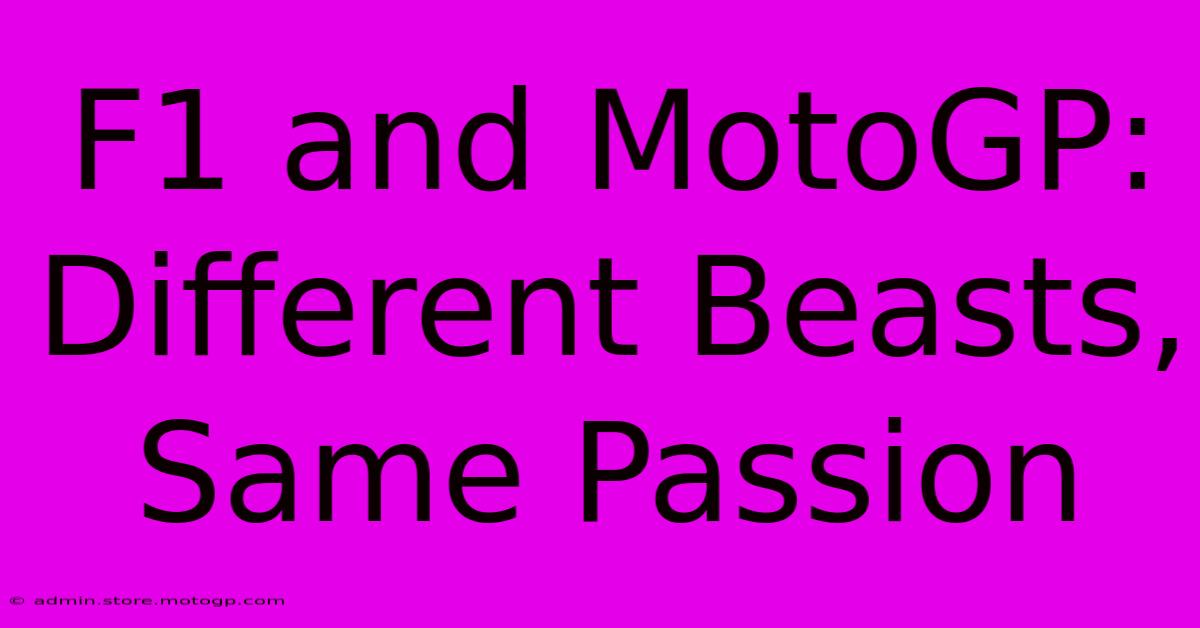F1 And MotoGP: Different Beasts, Same Passion

Table of Contents
F1 and MotoGP: Different Beasts, Same Passion
For motorsports enthusiasts, Formula 1 and MotoGP represent the pinnacle of their respective disciplines. Both attract millions of viewers worldwide, boast incredible feats of engineering, and demand superhuman skill from their competitors. But while they share a common thread of speed and adrenaline-fueled competition, F1 and MotoGP are fundamentally different beasts. This article delves into the key distinctions between these two captivating motorsports, highlighting their unique appeals and the shared passion that unites their fans.
The Machines: A Tale of Two Wheels and Four
The most obvious difference lies in the machinery itself. Formula 1 features sleek, open-wheel cars, powered by incredibly sophisticated 1.6-liter turbocharged hybrid engines. These cars are designed for ultimate downforce and grip, allowing them to corner at breathtaking speeds on purpose-built circuits. The focus is on raw power, aerodynamic efficiency, and precision handling at high speeds.
MotoGP, on the other hand, showcases powerful motorcycles, each a finely tuned symphony of engineering prowess. These bikes are lighter and more agile than F1 cars, relying on rider skill and intuition to navigate the track. While power is crucial, it's the rider's ability to manage the bike's throttle, brakes, and lean angle that ultimately determines success. The bikes themselves are a marvel of lightweight design, and the technology is constantly evolving.
Key Differences in Technology:
- Downforce: F1 cars generate immense downforce, pressing them to the track for incredible cornering speeds. MotoGP bikes rely more on rider skill and tire grip.
- Engine Technology: F1 uses complex hybrid power units, while MotoGP features high-revving internal combustion engines.
- Aerodynamics: F1 cars are heavily reliant on intricate aerodynamic designs, whereas MotoGP bikes utilize more streamlined fairings.
- Tire Technology: Different tire construction and compounds are used, tailored to the specific demands of each discipline.
The Riders: Human vs. Machine Interface
While both F1 and MotoGP drivers are elite athletes, their skill sets differ significantly. F1 drivers need exceptional car control, strategic thinking, and the ability to manage tire degradation and fuel consumption over long race distances. They're incredibly precise and technically adept, working in close collaboration with their engineering teams.
MotoGP riders, in contrast, require a level of physical dexterity and bravery that's unmatched. They need exceptional balance, core strength, and the ability to react instantly to changes in track conditions. Their connection with the machine is more visceral and intuitive, a true dance between human and machine. The g-forces experienced are intense, and their stamina is tested to the limit throughout the race.
Key Differences in Rider Skills:
- Physical Demands: MotoGP demands immense physical strength and stamina due to the intense forces and constant body movements.
- Precision and control: F1 drivers require precise control over the car's movements, while MotoGP riders need to manage the bike's balance and lean angle.
- Strategic awareness: While both need strategy, F1 requires more long-term strategic planning in relation to fuel, tire management, and race tactics.
The Tracks: Circuits and Courses
The venues themselves also contribute to the distinct characters of F1 and MotoGP. F1 circuits are typically designed for high-speed cornering, featuring long straights and sweeping curves. These tracks are meticulously maintained and designed for optimal racing conditions.
MotoGP tracks, while also demanding, tend to feature a greater variety of corners, both fast and slow, often incorporating elevation changes and tighter turns. Many MotoGP circuits use existing roads, resulting in unique track characteristics and layouts. This adds another layer of complexity and challenge for riders.
The Shared Passion: A Love for Speed and Competition
Despite their differences, both F1 and MotoGP ignite a shared passion for speed, competition, and technological advancement. The dedication of the drivers, the engineering marvel of the machines, and the thrill of the races create a powerful appeal for millions around the globe. Whether you prefer the raw power of F1 or the visceral excitement of MotoGP, one thing remains constant: the unwavering commitment to pushing the limits of human potential and technological innovation. This shared passion unites fans, creates vibrant communities, and cements the status of both F1 and MotoGP as iconic and enduring motorsports.
Conclusion: F1 and MotoGP, while distinct in their approaches, represent the pinnacle of motorsports. The differences in their machines, drivers, and tracks contribute to their unique characteristics, yet both captivate audiences with their raw speed, skillful competitors, and breathtaking competitions. The shared passion for these sports is undeniable, making them a thrilling spectacle for fans worldwide.

Thank you for visiting our website wich cover about F1 And MotoGP: Different Beasts, Same Passion. We hope the information provided has been useful to you. Feel free to contact us if you have any questions or need further assistance. See you next time and dont miss to bookmark.
Featured Posts
-
Experience The Luxury Of Cota Lot A Living
Feb 19, 2025
-
Cota Austin Unlock The Best Of Cota With Our Schedule
Feb 19, 2025
-
The Art Of The Ride Discover Our Replica Helmet Selection
Feb 19, 2025
-
Honda Moto Gp The Legacy Lives On
Feb 19, 2025
-
Feel The Speed Dynamic Moto Gp Images
Feb 19, 2025
